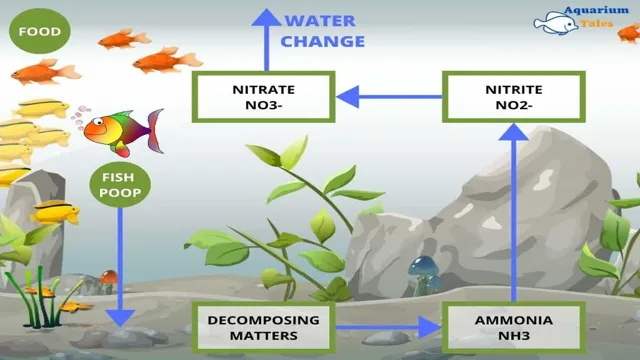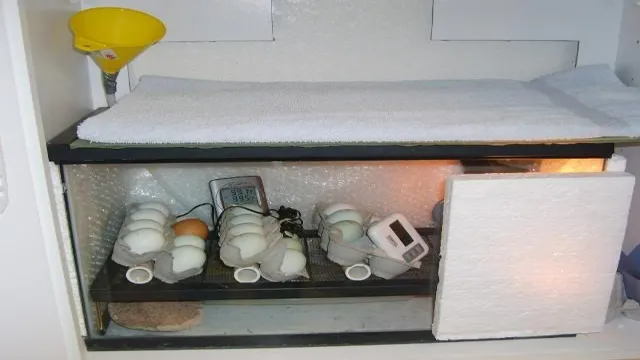As aquarium enthusiasts, we all want our aquatic creatures to be healthy, vibrant and thrive in their underwater homes. Proper maintenance of an aquarium can lead to a beautiful world of aquatic life, but it requires diligence and care. One of the key parameters that need to be monitored in an aquarium is the level of nitrates present in the water.
Nitrate is a toxic by-product of the nitrogen cycle that needs to be properly managed to maintain the health of your aquarium’s inhabitants. However, if you find that the nitrate levels are low, you may need to know how to raise nitrates in aquariums. So, let’s dive in and explore the various ways of doing so.
Why nitrates are important in aquariums
If you’ve ever owned an aquarium, you know that keeping the water quality in check is crucial for the health of your fish and other aquatic life. Nitrates are an essential component of a balanced aquarium ecosystem because they are necessary for plants and algae to grow. Furthermore, they also help reduce the levels of harmful ammonia and nitrite in the water.
However, sometimes nitrates can be difficult to maintain, especially in smaller tanks. Luckily, there are several ways to get nitrates up in your aquarium, such as adding live plants, feeding your fish smaller, more frequent meals, or using specialized fertilizers. By keeping a close eye on your water parameters, you can ensure that your aquarium remains a healthy and thriving oasis for your aquatic pets.
Nitrates as a source of nutrients for plants and algae
Nitrates are essential in aquariums because they serve as a source of nutrients for plants and algae. Plants and algae need nitrates to grow and thrive, and without enough of them, they may begin to wither and die off. One of the benefits of having plants and algae in your aquarium is that they can help absorb excess nitrates from the water, thus reducing the risk of high nitrate levels that can harm fish and other aquatic life.
However, it’s important to find a balance between having enough nitrates to support healthy plant and algae growth and avoiding excessive levels that can lead to water quality issues. Regular water testing and monitoring can help ensure that nitrate levels are within the appropriate range for your specific aquarium setup. By maintaining the right levels of nitrates, you can help create a thriving ecosystem in your aquarium that benefits all of its inhabitants.

Nitrates as an indicator of water quality
Nitrates are a crucial parameter for assessing water quality in aquariums because they are a key indicator of the health of the aquatic environment. Nitrates are a form of nitrogen that is essential for the growth of plants, but too much can harm aquatic life. Excessive levels of nitrates can lead to a phenomenon known as eutrophication, where the water becomes starved of oxygen and begins to smell.
Therefore, it is essential to monitor nitrate levels in aquariums regularly to ensure that they do not pose a risk to fish and plants. High levels of nitrates can be caused by over-feeding, over-stocking, inadequate filtration, and poor water circulation. One way to reduce nitrate build-up is through regular water changes.
By changing a portion of the water regularly, the nitrate levels can be effectively reduced, and the aquarium’s water quality can be maintained.
Testing for nitrates in aquariums
If you’re looking to get nitrates up in your aquarium, testing for them is key. There are a few different methods you can use to test the nitrate levels in your tank. One is to use a commercial nitrate test kit, which will usually involve adding a small amount of water sample to a test tube or other container and then adding a reagent that will react with any nitrates present.
Another option is to use a test strip, which will change color based on the amount of nitrates present in the water. Whichever method you choose, be sure to follow the instructions carefully and to retest frequently to determine any changes in nitrate levels over time. By keeping a close eye on nitrate levels and making adjustments as needed, you can ensure that your aquarium stays healthy and vibrant for years to come.
So go ahead and test those nitrates, your fish and other aquatic creatures will thank you!
Chemical test kits and their use
When it comes to maintaining a healthy aquarium, one important factor to consider is the level of nitrates in the water. To test for nitrates, many aquarium hobbyists turn to chemical test kits. These kits usually come with test strips or liquid reagents that change color in the presence of nitrates.
By comparing the color to a provided chart, you can determine the level of nitrates in your tank. It’s important to test your water regularly and make adjustments accordingly to keep your aquatic pets healthy and happy. Over time, high levels of nitrates can lead to algae growth, poor water quality, and increased stress for your fish. (See Also: How to Make a T5 Aquarium Light: A Step-by-Step Guide for Your Aquatic Setup)
By using a reliable test kit, you can stay on top of your tank’s nitrate levels and take action when needed. So, don’t forget to add this simple yet essential tool to your aquarium maintenance kit!
Interpreting test results
When it comes to keeping an aquarium healthy, testing for nitrates is essential. Nitrates occur naturally in aquariums as a byproduct of waste and decomposing matter. High levels can be harmful to fish and other aquatic life, so regular testing is crucial.
Nitrate test kits are available at most pet stores and are easy to use. Simply take a water sample and add the test solution according to the instructions. The results will give you a reading of the nitrate level in parts per million (ppm).
Ideally, nitrate levels should be below 40 ppm, with some experts recommending levels as low as 5 to 10 ppm. If your readings come back high, it may be necessary to perform partial water changes to reduce the nitrate level. Remember to always interpret test results in the context of the specific needs of your aquarium inhabitants.
Ways to raise nitrates in aquariums
If you’re struggling with low nitrates in your aquarium, there are several ways to raise them. First, consider adding live plants to your tank. Plants naturally remove nitrates from the water as they grow, but they also produce nitrates through their waste.
Adding more plants can help balance out the levels of nitrates in your aquarium. Another option is to increase the amount of fish in your tank. Fish waste contains a lot of nitrogen, which is converted into nitrates by the beneficial bacteria in your aquarium’s filter.
However, be sure not to overstock your tank as this can lead to poor water quality. Finally, you can add a liquid or powder fertilizer designed specifically for aquarium plants. These will contain nitrates and other nutrients that are essential for plant growth, which in turn will help raise the overall levels of nitrates in your aquarium.
By trying these methods, you should be able to successfully increase the nitrates in your aquarium and maintain a healthy aquatic environment for your fish and plants.
Adding fish food or fish waste to the tank
When it comes to maintaining a healthy aquarium, maintaining proper nitrate levels is crucial. Nitrates are a natural byproduct of the nitrogen cycle that occurs in aquariums, but if they become too high, they can be harmful to fish and other aquatic life. One way to raise nitrates in your aquarium is by adding fish food or fish waste.
Fish food and waste contain organic matter that will break down and release ammonia, which will eventually convert to nitrate. However, it’s important to be mindful of how much food you add to avoid overfeeding your fish and causing ammonia spikes, which can be harmful to your aquatic inhabitants. Regular water testing can help you keep track of nitrate levels and adjust your feeding regimen accordingly.
By properly managing your aquarium’s nitrate levels, you can create a healthy and thriving underwater habitat for your aquatic friends to enjoy.
Using commercial nitrates supplements
If you are looking to raise the nitrates levels in your aquarium, using commercial nitrate supplements can be an effective and efficient option. These supplements are readily available at your local pet store or online and are often in powder or liquid form. However, it’s essential to remember that overusing these supplements can fluctuate the nitrates levels and harm your aquatic animals. (See Also: How to Make an Aquarium in Minecraft Survival: A Step-by-step Guide)
Therefore, it’s necessary to keep a consistent dosing schedule and monitor the levels regularly. One of the popular commercial nitrate supplements available in the market is potassium nitrate, which can help raise the levels to the desired range. Additionally, considering other sources of nitrates like fish food, live plants, and adding natural materials like driftwood can also complement the commercial supplements.
Always remember to test and maintain a consistent balance in your aquarium’s nitrates levels to keep your aquatic friends healthy and happy.
Growing live plants in the tank
If you’re struggling to maintain the proper level of nitrates in your aquarium, growing live plants is an excellent way to help increase these levels naturally. There are several ways you can accomplish this, depending on the type of plants you choose to grow. For instance, fast-growing plants like hornwort or duckweed can rapidly consume nitrates, while stem plants like anacharis or ludwigia can help remove excess nitrates as they grow.
Additionally, rooted plants like swords and crypts absorb nitrates through their roots, helping to reduce nitrate levels in the water column. By including live plants in your aquarium setup, you can create a natural and healthy environment for your aquatic pets while ensuring that nitrate levels remain at optimal levels. So why not consider adding some greenery to your aquatic landscape and see the positive effects it can have?
Precautions when raising nitrates
If you’re a seasoned aquarist, then you know how essential nitrates are in maintaining a healthy aquatic environment. However, raising the nitrate levels in your tank requires careful planning and monitoring to avoid harmful consequences. Firstly, ensure that you use high-quality testing kits that produce accurate results.
A common mistake many people make is overfeeding their fish to increase nitrate levels. This can create an ample supply of organic matter for ammonia-producing bacteria, which can lead to a spike in ammonia and other harmful toxins. Instead, aim to increase nitrate levels by adding small portions of fish food or using specialized nitrates additives.
It’s also essential to maintain a regular water-changing schedule to prevent overloading your tank with excess nutrients and other pollutants. Keep in mind that while nitrates are necessary for plant and algae growth, excessively high levels can still be harmful to your aquatic inhabitants. Maintaining healthy nitrate levels is all about finding the right balance, so don’t hesitate to seek advice from experienced aquarists if you’re unsure.
Avoiding overfeeding and carbon dioxide buildup
When it comes to raising nitrates, it’s crucial to pay attention to a couple of important precautions. Firstly, overfeeding your tank can lead to a buildup of excess nitrates. This occurs as fish food, uneaten by your aquatic pets, decomposes, releasing compounds rich in nitrogen and phosphorus into the water, which bacteria will then break down into nitrates.
These high levels of nitrates can become toxic to your fish over time, so it’s important to monitor feeding habits and stick to a schedule. Additionally, high levels of nitrate can cause excessive carbon dioxide buildup, potentially harming your fish even further. To avoid this, it’s important to use a good filtration system, perform regular water changes and ensure proper ventilation.
By staying vigilant and taking these precautions, you can keep your fish healthy and happy while maintaining proper water chemistry.
Regular water changes to prevent excessive nitrates
Raising nitrates in an aquarium can be problematic for the fish and other aquatic creatures living there. While nitrates are a natural byproduct of the nitrogen cycle, too much of them can harm the fish by causing bloating and poisoning them over time. One of the best ways to prevent excessive nitrates is by doing regular water changes.
This involves removing a portion of the tank water and replacing it with fresh tap water treated with a conditioner to remove any harmful chemicals. By doing this, you can lower the nitrate levels and dilute any other pollutants that may have accumulated in the water. The frequency of these water changes will depend on the size of the tank, the number of fish, and how much they are fed, but it’s generally recommended to do a 10-25% water change every 2 weeks.
This way, you can ensure that your aquatic pets live in a healthy and safe environment. (See Also: How to Aquarium Plumbing Union: The Ultimate Guide for Seamless Connections)
Conclusion
So there you have it, folks! Getting nitrates up in your aquarium might seem daunting at first, but with a few key tweaks and a bit of patience, it’s totally doable. Just remember: like most things in life, balance is key. Don’t overdo it on the fish food, but don’t slack off on water changes, either.
Test your water regularly, and be patient as you wait for those nitrates to rise. And if all else fails, just add a few bags of spinach to your tank and watch the magic happen! Happy fish-keeping!”
FAQs
What causes low nitrate levels in an aquarium?
Low fish load, lack of fertilization, and efficient biological filtration can all contribute to low nitrate levels.
Is it safe to add fertilizer to increase nitrate levels in an aquarium?
Yes, but it is important to follow the instructions carefully and not overdo it. Excessive fertilizer can harm aquatic life.
Can live plants help increase nitrate levels in an aquarium?
Yes, live plants are a natural source of nitrates and can help maintain levels in the aquarium.
What are some common sources of nitrates in an aquarium?
Fish waste, uneaten fish food, and decaying organic matter are all common sources of nitrates in an aquarium.
How often should nitrate levels be tested in an aquarium?
Nitrate levels should be tested at least once a week, and more often if the aquarium is heavily stocked.
Can water changes help increase nitrate levels in an aquarium?
No, water changes actually lower nitrate levels. However, they can help maintain a healthy aquarium environment by removing harmful toxins.
What is the ideal level of nitrates in an aquarium?
The ideal range for nitrates in an aquarium is 5-20 ppm (parts per million), but this can vary depending on the type of aquatic life being kept.







